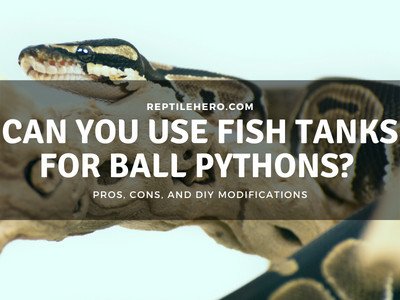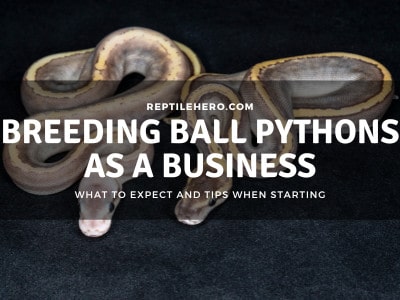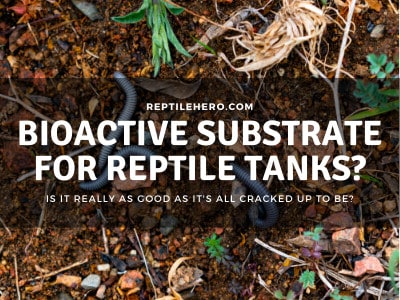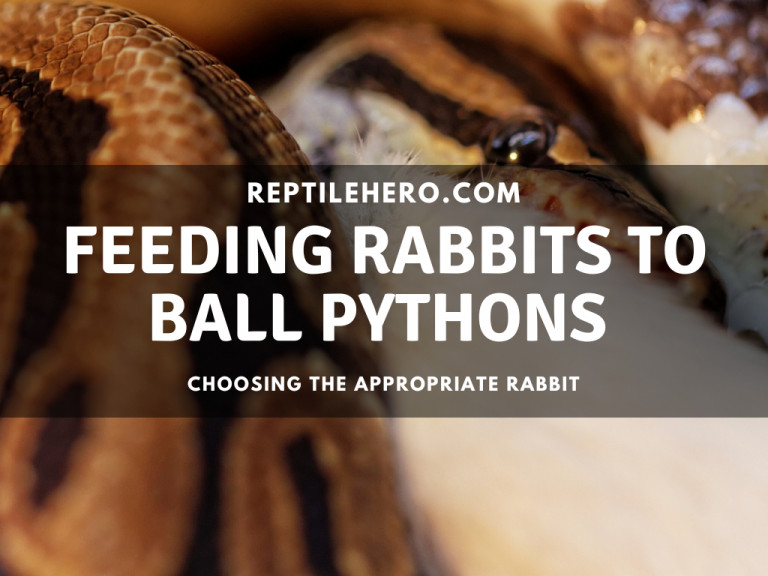Why is My Ball Python so Active? (6 Reasons)
Most of us wondered and worried (at some point) why our ball python moves a lot inside its enclosure. Is this normal, or is there an underlying problem that we need to fix?
A ball python may become more active than usual because of: 1) new surroundings; 2) young age; 3) hunger; 4) nighttime; 5) breeding season; 6) improper enclosure conditions (such as inadequate temperature, humidity, substrate, or a not clean enclosure).
Let’s discuss the possible reasons why your ball python is active. Should you be worried or not?
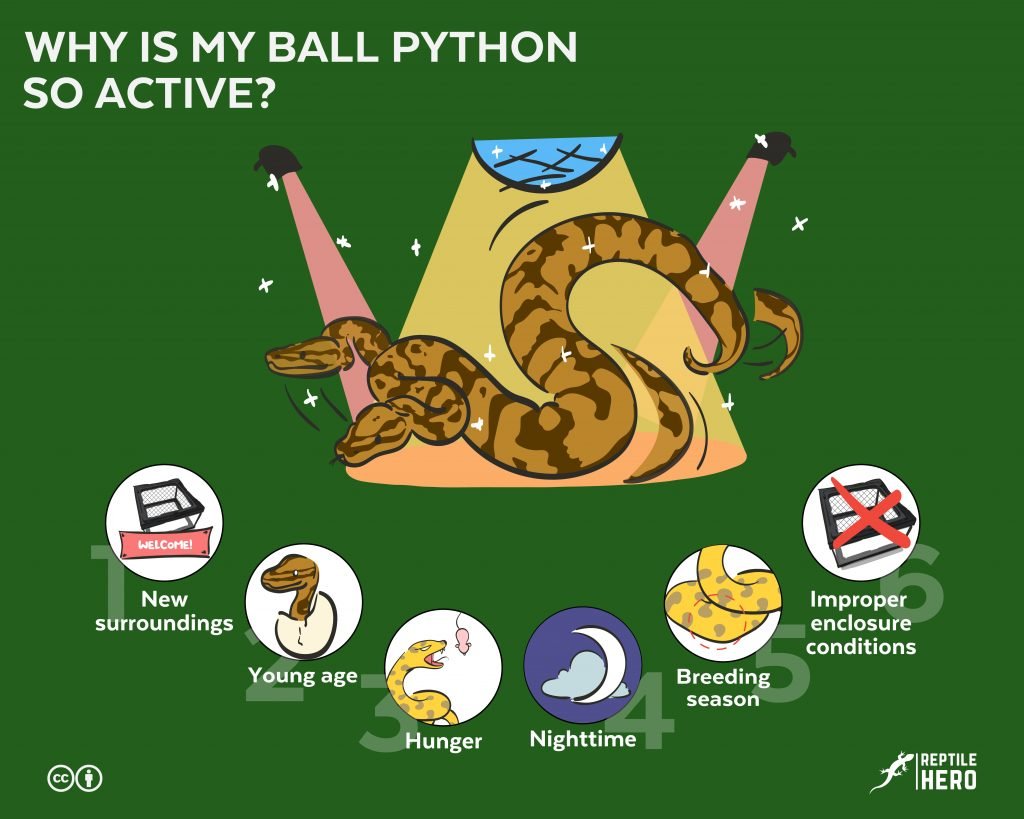
1. New Surroundings
Ball pythons become active in a new environment, such as a new enclosure. It takes more or less than one to two weeks for a ball python to settle in a new cage.
I remember bringing home my first ever ball python and naming him “Tesla.” I put him right away inside his enclosure and observed for almost an hour. I witnessed how curious a ball python may become towards its new environment.
So, don’t worry if you just brought home a ball python and it seems restless. Ball pythons are curious creatures that explore a lot in new surroundings.
One of the signs that your ball python has settled in is that it hides. The general rule in ball python keeping is that “A hiding ball python is a happy ball python.”
If your ball python does not get back to the average activity level after two weeks, you might want to check your enclosure setup (temperature, humidity level, etc.).
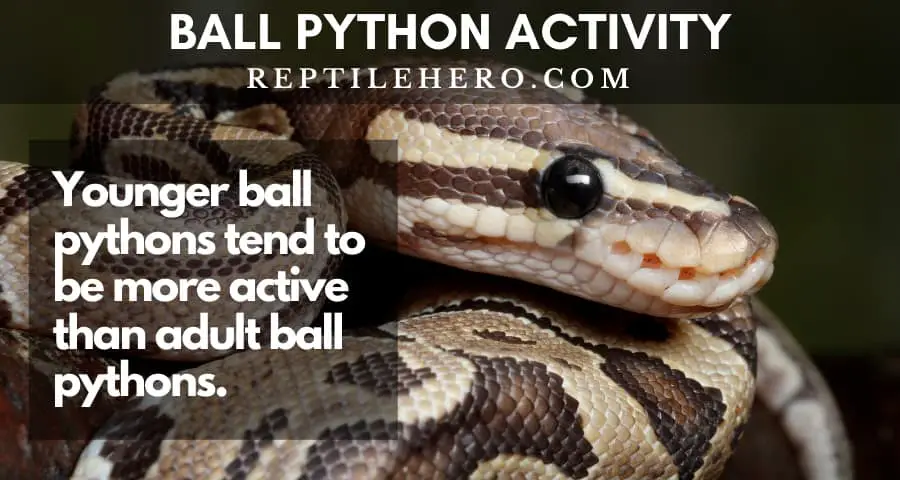
2. Young Age
Younger ball pythons tend to be more active than adult ball pythons inside their enclosure.
Many breeders say that younger ball pythons are more active than their adult counterparts, and I have seen it countless times.
Whenever I observe my beloved snakes, my young ball pythons move a lot compared to adult ones. Some are trying to escape while others are just exploring around their enclosures.
Age can be a factor why your ball python is active inside its enclosure.
3. Hunger
Ball pythons become suddenly active because they are hungry and aware of the coming feeding time. Also, if a ball python perceives prey in its surroundings, it can become more active.
According to many breeders, ball pythons know the cycle of their feeding. I experimented with it to find out if it was true when I was still new to ball python keeping.
I wrote the exact feeding date and time of one of my ball pythons and closely observed him the following days until the next feeding session. My ball python’s activity was regular until the following feeding schedule came.
My ball python became more active than usual. He flicked his tongue many times and moved a lot compared to those days before the actual feeding time. By doing this, I learned firsthand that ball pythons in captivity do know their feeding cycles.

After doing that little experiment, I did another one. I was curious this time if my ball pythons could sense their meal even without seeing them. I did this little experiment during the daytime when they were asleep.
Before entering the room where I keep my snakes, I ensured that the feeders weren’t making any noise and my ball pythons were hiding. I put live feeders inside a shoebox and placed them on the floor.
After a minute or two, my ball pythons became active and came out one by one, flicking their tongues while moving around the enclosure.
4. Nighttime
Ball pythons are nocturnal creatures that are naturally more active during the night.
The ball pythons are most active from dusk until dawn. That’s why many breeders encourage new keepers to feed their ball pythons at night to mimic the time when they hunt in the wild.
5. Breeding Season
Ball pythons, especially males, may become suddenly active during the breeding season. Most male ball pythons tend to skip their meals and focus more on mating.
You may notice your ball python go off-feed but still active when breeding season starts. From my experience, most of my male ball pythons go off-feed when breeding season comes. Breeding season starts from mid-September, when the temperature drops, until mid-November.
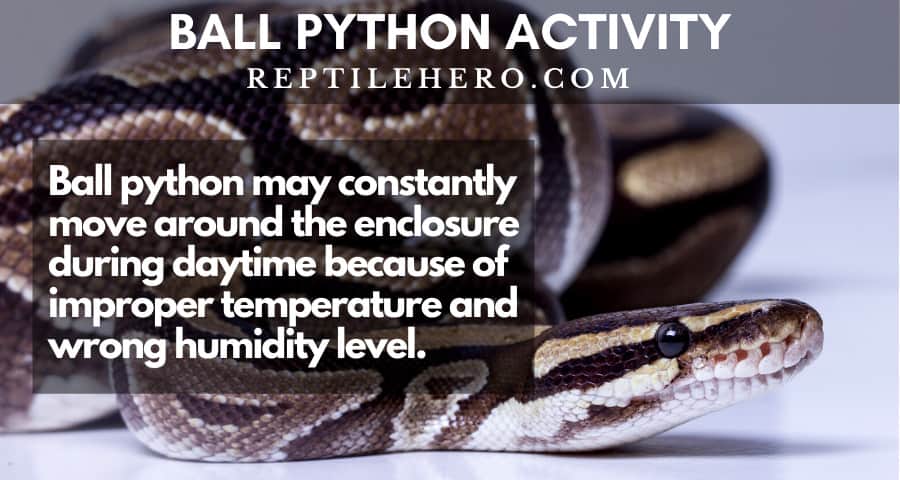
6. Improper Enclosure Conditions
A ball python may become suddenly active during the daytime because of stress due to its enclosure’s improper conditions. To emulate the ball python’s natural habitat, the enclosure should have:
Your ball python may become active during the daytime because it might be stressed due to its enclosure’s improper conditions. For the welfare of our beloved ball pythons, we have to mimic the conditions of their natural habitat in Central and Western Africa. [1][2]
Improper Temperature
The recommended air temperature in the cool side of a ball python’s enclosure is 80-85°F. Having a lower temperature may result in respiratory infections. The required temperature in the ball python’s hot spot is 90°F. The use of thermostats together with any heating equipment for the ball python’s enclosure is strongly advised.
To imitate the temperature of our ball python’s natural habitat, we have to set the cool side air temperature of the enclosure to 80-85°F. Respiratory infections may occur to our snakes if the air temperature inside their enclosure goes lower. If you ask if the temperature in your place is lower or you have a cold climate in your area, then using a ceramic heat emitter (CHE) is advised.
90°F is the highly recommended temperature of the hot spot of our ball pythons. Ball pythons are not “basking” animals and they get most of the heat by their belly. The use of an under-tank heater (UTH) is recommended. The perfect placement of UTH is on the opposite of the cool side and under (not inside) your snake’s enclosure.
Improper Humidity
The recommended humidity level inside the ball python’s enclosure is 55-60%. Having lower humidity may result in dehydration in ball pythons. The humidity inside the ball python’s enclosure can be increased up to 85% through misting when a ball python is in the shedding process.
When your ball python is shedding, increasing the humidity up to 85% by misting inside the enclosure is advised to prevent a stuck shed. Stuck sheds in ball pythons occur when the humidity inside the enclosure is low.
Substrates like coco husk may affect the humidity inside your ball python’s enclosure because it holds more moisture than other substrates. Attaching a humidity gauge like this one from Amazon makes identifying the humidity level inside your ball python’s cage easier. A digital humidity gauge is proven to be more accurate than analog ones.
Inappropriate Substrate
Appropriate substrate should be used for the ball python’s enclosure. Inappropriate substrates can cause stress to ball pythons.
Different substrates are based on your personal preference, sometimes, your ball python’s. There are cases where ball pythons were stressed because they were not content with their substrate. Different substrates such as coco husk/fiber, white paper towels, newspaper, etc., can be used.
Dirty Water
Ball pythons should have access to clean water at all times. A ball python tends to soak itself in the drinking bowl because it needs more humidity for an incoming shed or it has mites.
One of ball python-keeping essential requirements is having your snake access clean water. A drinking bowl will serve as drinking water for your ball python, and your snake will soak itself in it. Often your ball python may soak itself because it needs more humidity for shedding or it has mites.
The recommended size of a water bowl is large enough for your ball python to submerge itself in and shallow enough to prevent your snake from drowning.
According to many owners, you can change your ball python’s water every other day. But for my peace of mind, I change my ball python’s water every day.
Dirty Enclosure
Ball python’s enclosure should always be cleaned and maintained. Dirty enclosures are the ideal environment for the spreading of diseases such as the one responsible for scale rot.
Aside from the required materials and temperatures mentioned above, the most critical aspect of ball python keeping is keeping their enclosure clean. You need to maintain the cleanliness of your ball python’s enclosure to prevent it from having skin infections such as scale rot.
Spot-cleaning can be done whenever your ball python urinates and defecates. Depending on which substrate you use, you can clean and replace the portion (or whole) of it and clean the dirty part of the enclosure.
General cleaning includes cleaning the whole enclosure, replacing the substrate, cleaning the hides, etc., which can be done weekly or every two weeks. I don’t do spot-cleaning because I use paper towels as substrate. I clean the whole enclosure whenever it is needed.
Summary of Why Your Ball Python is Too Active
A ball python might become active because of: new surroundings; younger age; hunger; nighttime; breeding season; improper enclosure conditions such as improper temperatures, improper humidity, inappropriate substrate, dirty water, and dirty enclosure.
The parameters inside the ball python’s enclosure should mimic the condition of its natural habitat. The recommended air temperature in the cool side of a ball python’s enclosure is 80-85°F. A ceramic heat emitter (CHE) can generate the required temperature, especially in places with cold climates. The needed temperature in the ball python’s hot spot is 90°F. The use of an under-tank heater (UTH) is recommended as ball pythons acquire heat from their belly. The use of thermostats together with CHE and UTH is strongly advised.
The recommended humidity level inside the ball python’s enclosure is 55-60%. Having a lower humidity level may cause dehydration in ball python. When a ball python is shedding, the humidity level can be increased up to 85% through misting around the enclosure to avoid stuck shedding.
The ball python enclosure should have: an appropriate substrate such as newspaper, paper towels, coco husk/fiber, etc.; access to clean water in a shallow dish; cleaning maintenance.
Sources
[1] D’Cruze, N.; Wilms, T.; Penner, J.; Luiselli, L.; Jallow, M.; Segniagbeto, G.; Niagate, B. & Schmitz, A. (2021). “Python regius”. 2021: e.T177562A15340592. Retrieved 7 October 2021.
[2] Western Africa (e.g. Sierra Leone, Togo, Senegal) Mehrtens, J. M. (1987). “Ball Python, Royal Python (Python regius)”. Living Snakes of the World in Color. New York: Sterling Publishers. p. 62–. ISBN 080696460X.

